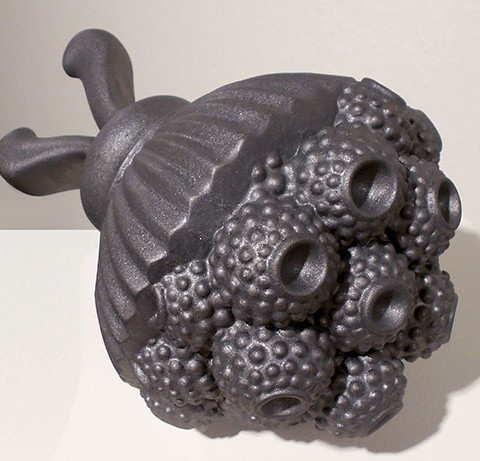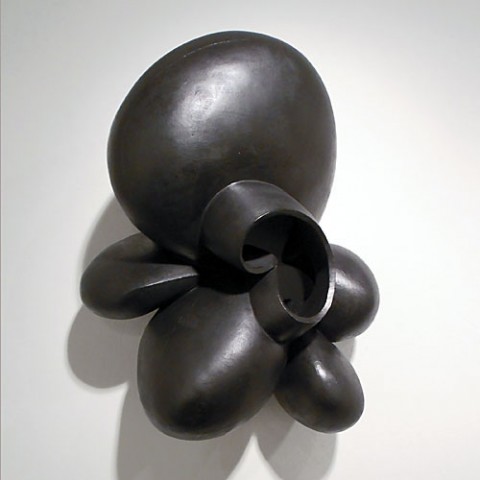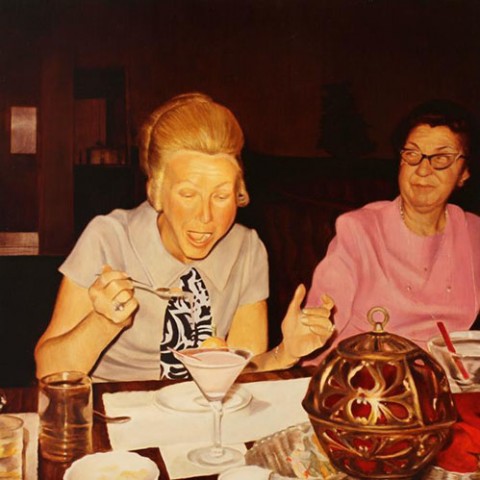Kris Lyons, Mark Boguski & Patrick Marasso @ JAYJAY
Posted on 14 February 2013.
Over the past generation clay sculpture has moved so far from its beginnings in craft and functional object making that to attach the prefix – ceramic – seems almost anachronistic. Yet for sculptors working in clay, the “taint” of pots and teacups still lingers, and for some, like Kris Lyons, the rejection of that association is a motivating force.
Thus, the highest compliment I can bestow upon Lyons is to say that her work cannily disguises its origins. Her mash-ups of ornamental, organic and industrial shapes look as if they’d been output on a 3-D printer – the kind designers use to create prototypes. Her slip cast forms, based on plants, resemble sci-fi children’s toys or “space junk”, an impression heighted by the artist’s use of a spray-on glaze that mimics flocking. The result is fuzzy-surfaced objects that mix incompatible references. Grenade-like shapes meet a pinion gear in Bullion Festoon. Molecular orbs cluster around a pediment in Clutch, and in Ornamental Grid, exhaust pipes sprout from shapes that might, in a different context, be read as wall sconces.
Lyons cites the photographic team of Bernd and Hilla Becher as a key influence which, at first, seems incongruous — until you grasp the similarities between her hybrid forms and the Becher’s typological studies of water towers which, in turn, bring to mind another German photographer of a much earlier vintage: Karl Blossfeldt (1865-1932), a plant specialist. More surprising still: Lyons uses words like “taste”, “flavor” “crunch” and “mouth feel” to describe the desires she hopes to arouse in viewers. I can see chocolate truffles in the round shapes that comprise Clutch. But I feel no sugar pangs. The main pleasure I get from of these objects derives from their polymorphous nature.
Lyons’ partner, Mark Boguski, shares her ethos, but takes a more traditional path, one that invokes the vessel making tradition without being held hostage to it. His bulbous shapes – pinched in the manner of balloon sculptures – recall, in color and sheen, Oaxacan Barro Negro pottery. These works are exuberant celebrations of biomorphism, alternately “sprouting” off walls (One) and “growing” from ceramic platters (Zwischen) like cells in a petri dish. In their curves, orifices and luminous finish we see echoes of symbolism, and, in their gawkiness, John Chamberlain’s bound urethane foam sculptures. These bold, pure forms don’t seek to overturn or subvert anything; they simply ask to be admired for their eccentricities.
Patrick Marasso presents a more complicated proposition. He takes found snapshots of middle- and working class people at play and renders them in ghoulish tints that making the source imagery appear as if it had been marinated in iodine – an effect I thought improbable until I discovered a family photo album of my own with similar characteristics.
Judging from clothing, haircuts, furnishings, cars and other background paraphernalia, Marasso favors the ‘70s and ‘80s. His paintings, which measure 15 x 15 inches, are a catalog of unsavory Americana: bad hair, bad food, bad physiques and bad fashion.
The pictures operate between repulsion and self-recognition, and in that polarized zone they wield real power. Marasso is hardly the first painter to work from photographs, but his readily identifiable technique (and decidedly retro sensibility) exemplify the best kind of interchanges currently taking place between painting and photography.
Granted, clay sculpture and realist painting don’t have in much common. But it doesn’t seem to matter. This is an unusual and adventurous show that is well worth catching.





